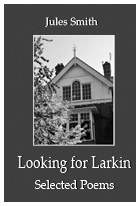Looking for Larkin is the first full length collection of Jules Smith’s poetry. Handsomely produced, it also contains a sequence of photographs by Dan Lyons which capture some of the monuments, wharves and streets of ‘Larkinland’ in and around Hull. Surprisingly, perhaps, for a poet who has been widely published since the early eighties, this is the first substantial gathering of his work. In ‘the Barefoot Bride’, which opens the collection and is placed alongside a shot of Pearson Park, Smith beautifully distils the influence of his master. Addressing a beloved with the Larkinesque endearment of ‘Darling’, he then describes a bride and wedding group in terms which are clearly intended to echo ‘The Whitsun Weddings’:
She trailed her ivory, wind-ravelled train
across the road to greet guests warmly,
colours sun-mingled as in a kaleidoscope .
Like the protagonists in many of Larkin’s poems, Smith is an outsider looking on, his ‘incline towards the curves of their talk / distanced by not knowing the family.’ Having described the stock figure of the best man sitting ‘on a low wall / like Humpty Dumpty, flirting with women’, he brings the poem to its conclusion with a quietly effective image which rings the changes on the fertility theme which is also important in Larkin’s poem: ‘Behind them all, the garden. Freshly dug.’
In ‘Looking for Larkin’, the collection’s title poem, Smith’s elusive eminence grise actually becomes his subject. Accompanied by an enigmatic photograph of Larkin’s flat in Pearson Park, this is another highly intertextual poem in which Mr Larkin is recreated in the image of his own ‘Mr Bleaney’, so that now the room which once belonged to ‘that novelist chappy’ has been ‘turned over to a well-balanced bloke / unafraid of ghosts, Pink Floyd posters on the walls.’ With a few deft strokes Smith gives us a convincing ‘warts and all’ portrait of the poet ‘almost capering’ to his classic jazz whilst at the same time he is ‘spying on “honeys”’. However, more than this, the piece is also a moving study on the subject of mortality in which the music changes with the decades and thirty years are reduced to ‘30 seconds on “News at Ten”’. Moreover, lest anyone think that Smith is merely an exponent of clever pastiche, he concludes with some bravura imagery that is entirely his own:
Coming and going across Pearson Park
some see orange and pink lamplights,
others luminous Larkinesque socks
against the evening’s darkening suit.’
Having established the Larkin theme, Smith proceeds to cast his net more widely. In ‘She’ he evokes his own adolescence by describing the erotic and ‘fulfilled figure’ of Ursula Andress rising from the waves in Dr. No. It is also the first of several poems inspired by the poet’s love of the cinema. Here, from the film version of King Solomon’s Mines, is the princess Ayesha disintegrating before our eyes:
Then the change in her. Stifled crying out,
corruption showing first on her spotted hands,
flesh jerking past the frames of desire
through such processes only film can fake.
Witty, intelligent, and full of fun, it must also be admitted that the allusiveness of this and many other poems here makes plenty of demands upon the reader. Alongside its cinematic references to Ian Fleming and Rider Haggard, there are echoes of Charles Aznavour, Larkin’s Mrs T, Ecclesiastes, Keats and no doubt others which the present reviewer has missed. Further highly entertaining excursions into the world of the silver screen are ‘Brief Encounter’, where ‘a veil of light separates art from life,’ and ‘The Fall of the House of Hitchcock’ which evokes ‘Female hip and automobile in Fifties curves, / cantilevers of bra and bridge.’
Central to Looking for Larkin is its virtuoso showcase ‘Poets’ Night on the S.S. Manxman’, a dazzling mock heroic epic in which Smith shows himself to be Hull’s answer to Dryden and Pope or, perhaps more appropriately, Clive James. There is no space here, and probably no need, to examine the rich literary heritage of ‘The Rumoured City’, other than to say that, from Larkin, Dunn, O’Brien and beyond, the list of poets seems endless, including figures such as Roger McGough and Tom Paulin who may not be immediately associated with the city, or Oliver Reynolds who started out with Faber in a blaze of glory but seems subsequently to have faded away. Over the years Smith himself has played a not insignificant role in this tradition and, via his long association with John Osborne’s journal Bête Noire, was well placed to observe the shenanigans and foibles of the city’s literati. Extending over twelve pages and featuring some dozens of poets, it would be invidious to focus on individuals in a poem which Smith refers to as ‘a long poem / on a long night, on a long boat. / A work of libel and celebration.’ There is, however, mayhem and bickering aplenty which is frequently fuelled by drink. Perhaps, as someone is alleged to have said about the Sixties: ‘If you can remember, you weren’t there.’ On a smaller scale, but just as hilarious and well observed is ‘Flannnerie’ in which the poet sharpens his scalpel on the Irish literary scene from Joyce and Flann O’Brien down to the more recent days of ‘Famous Seamus, the mud poet’ and ‘Fungus McMahon’.
A poem such as ‘Poets’ Night on the S.S. Manxman is bound to have a particular appeal for those who were a part of the ‘scene’ it depicts, so that those who were not may at first glance feel excluded. However, Smith’s brio and incisiveness, his skill with rhymes and rhythms and his frequently outrageous imagery are very appealing. Poets are, by and large, at least as fatuous and self-obsessed as everyone else and, whether the scene is the Roman Republic of Catullus or the coffee shops of Augustan London, it is always entertaining to see their vanities on display. The S.S. Manxman is a worthy reinvention of the ‘Ship of Fools.’ It would, however, be a mistake to see Smith as merely a gifted satirist and literary annalist. ‘On My Birthday’ is an endearingly nostalgic evocation of a Sixties childhood. Disappointed to discover that his postbox is empty, the poet is taken back to earlier days: ‘Back in bed I’m mindful of ten-bob notes, / riding the range of the back garden under a cowboy hat.’ ‘Shinglers F.C.’ returns to the same period and memorialises the doughty determination of its eponymous football team. In ‘Tomorrow’s People’ the old men ‘tending their allotments’ at the end of their lives are compared to ‘figures in a Breueghel landscape’ who are reduced to merely ‘doing something.’
Finally, if proof were needed that there is more to Smith than postmodernist high jinks and literary knockabout, one needs to look no further than ‘Graduation’, his austerely sustained meditation upon the death of his father:
The ceremony went well. Eulogies,
gowned ritual, a sense of having passed
onto that brief handshake with authority.
A liberation of sorts. Me to play.
Outside, the life of summer transcendent…
As in Beckett and some of the later poems of Larkin, Smith’s depiction of old age is relentless in its awfulness:
Being able to ‘take his drink’ left years
of enfeebled hopping on painkillers,
degeneration towards a chairbound,
legless, sightless, completely finished
dustbin character escaped from Beckett.
‘Cantankerous, humourless, feckless,’ the father is a figure who, having passed on, is ‘no longer / there to be feared,’ yet somehow, too, in spite of the tensions between the father and the son he dismisses sarcastically as ‘sugar plum’, big ‘ead’, ‘the professor’, the poet also recalls moments of togetherness when father and son shared late night ‘steak and kidney pies I wouldn’t eat now.’ Looking for Larkin is a varied and engrossing collection which is, by turns, funny, nostalgic and moving. It is beautifully illustrated by Dan Lyons and doesn’t have a dull page in it.
Looking for Larkin by Jules Smith is published by Flux Gallery Press and priced at £8.95. Order your copy here.

